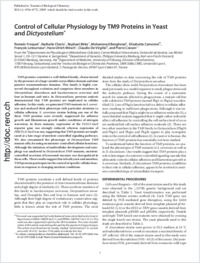Control of cellular physiology by TM9 proteins in yeast and Dictyostelium
- Froquet, Romain Département de Physiologie et Métabolisme Cellulaire, Centre Médical Universitaire, Université de Genève, Switzerland
- Cherix, Nathalie Département de Physiologie et Métabolisme Cellulaire, Centre Médical Universitaire, Université de Genève, Switzerland
- Birke, Raphael Department of Genetics, Philipps University Marburg, Germany
- Benghezal, Mohammed Département de Physiologie et Métabolisme Cellulaire, Centre Médical Universitaire, Université de Genève, Switzerland
- Cameroni, Elisabetta Division of Biochemistry, Department of Medicine, University of Fribourg, Switzerland
- Letourneur, François Institut de Biologie et Chimie des Protéines, Université Lyon, France
- Mösch, Hans-Ulrich Department of Genetics, Philipps University Marburg, Germany
- De Virgilio, Claudio Division of Biochemistry, Department of Medicine, University of Fribourg, Switzerland
- Cosson, Pierre Département de Physiologie et Métabolisme Cellulaire, Centre Médical Universitaire, Université de Genève, Switzerland
-
03.01.2008
Published in:
- Journal of Biological Chemistry. - 2008, vol. 283, no. 11, p. 6764-6772
English
TM9 proteins constitute a well defined family, characterized by the presence of a large variable extracellular domain and nine putative transmembrane domains. This family is highly conserved throughout evolution and comprises three members in Dictyostelium discoideum and Saccharomyces cerevisiae and four in humans and mice. In Dictyostelium, previous analysis demonstrated that TM9 proteins are implicated in cellular adhesion. In this study, we generated TM9 mutants in S. cerevisiae and analyzed their phenotype with particular attention to cellular adhesion. S. cerevisiae strains lacking any one of the three TM9 proteins were severely suppressed for adhesive growth and filamentous growth under conditions of nitrogen starvation. In these mutants, expression of the FLO11-lacZ reporter gene was strongly reduced, whereas expression of FRE(Ty1)-lacZ was not, suggesting that TM9 proteins are implicated at a late stage of nutrient-controlled signaling pathways. We also reexamined the phenotype of Dictyostelium TM9 mutant cells, focusing on nutrient-controlled cellular functions. Although the initiation of multicellular development and autophagy was unaltered in Dictyostelium TM9 mutants, nutrient-controlled secretion of lysosomal enzymes was dysregulated in these cells. These results suggest that in both yeast and amoebae, TM9 proteins participate in the control of specific cellular functions in response to changing nutrient conditions.
- Faculty
- Faculté des sciences et de médecine
- Department
- Département de Biologie
- Language
-
- English
- Classification
- Biological sciences
- License
-
License undefined
- Identifiers
-
- RERO DOC 11177
- DOI 10.1074/jbc.M704484200
- Persistent URL
- https://folia.unifr.ch/unifr/documents/300759
Statistics
Document views: 85
File downloads:
- pdf: 187
